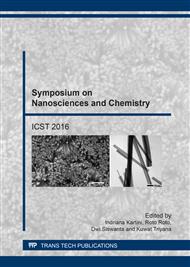[1]
J. Pól, B. Hohnová, T. Hyötyläinen, Characterisation of Stevia Rebaudiana by comprehensive two-dimensional liquid chromatography time-of-flight mass spectrometry. J. Chromatogr. A. 1150 (2007) 85–92.
DOI: 10.1016/j.chroma.2006.09.008
Google Scholar
[2]
S. Gregersen, P.B. Jeppesen, J.J. Holst, K. Hermansen, Antihyperglycemic effects of stevioside in type 2 diabetic subjects. Metabolism. 53 (2004) 73–76.
DOI: 10.1016/j.metabol.2003.07.013
Google Scholar
[3]
R.S. Kujur, V. Singh, M. Ram, H.N. Yadava, K.K. Singh, S. Kumari, B.K. Roy, Antidiabetic activity and phytochemical screening of crude extract of Stevia rebaudiana in alloxan-induced diabetic rats. Pharmacogn. Res. 2 (2010) 258-263.
DOI: 10.4103/0974-8490.69128
Google Scholar
[4]
N. Shivanna, M. Naika, F. Khanum, V.K. Kaul, Antioxidant, anti-diabetic and renal protective properties of Stevia rebaudiana. J. Diabetes Complications 27 (2013) 103–113.
DOI: 10.1016/j.jdiacomp.2012.10.001
Google Scholar
[5]
K. Chester, E.T. Tamboli, M. Singh, S. Ahmad, Simultaneous quantification of stevioside and rebaudioside A in different stevia samples collected from the Indian subcontinent. J. Pharm. Bioallied Sci. 4 (2012) 276–281.
DOI: 10.4103/0975-7406.103236
Google Scholar
[6]
U. Wölwer-Rieck, The Leaves of Stevia rebaudiana (Bertoni), Their Constituents and the Analyses Thereof: A Review. J. Agric. Food Chem. 60 (2012) 886–895.
DOI: 10.1021/jf2044907
Google Scholar
[7]
L.K. Hearn, P.P. Subedi, Determining levels of steviol glycosides in the leaves of Stevia rebaudiana by near infrared reflectance spectroscopy. J. Food Compos. Anal. 22 (2009) 165–168.
DOI: 10.1016/j.jfca.2008.10.008
Google Scholar
[8]
Q. Tang, D. Min, T. Hu, G. Kai, Y. Wang, Determination of the content of Steviol Glycoside in Stevia rebaudiana by Near Infrared Spectroscopy (NIRS). Medicinal Plant 5 (2014) 33-35.
Google Scholar
[9]
C. Yu, K. Xu, Y. Shi, The spectrum model established for measuring the contents of Rebaudioside A and Stevioside quickly in the leaves of Stevia rebaudiana Bertoni. Energy Procedia 5 (2011) 855–861.
DOI: 10.1016/j.egypro.2011.03.151
Google Scholar
[10]
W. Li, L. Xing, Y. Cai, H. Qu, Classification and quantification analysis of Radix scutellariae from different origins with near infrared diffuse reflection spectroscopy. Vib. Spectrosc. 55 (2011), 58–64.
DOI: 10.1016/j.vibspec.2010.07.004
Google Scholar
[11]
L. Wang, F.S. C. Lee, X. Wang, Near-infrared spectroscopy for classification of licorice (Glycyrrhizia uralensis Fisch) and prediction of the glycyrrhizic acid (GA) content. LWT - Food Sci. Technol. 40 (2007) 83–88.
DOI: 10.1016/j.lwt.2005.08.011
Google Scholar
[12]
L. Liu, D. Cozzolino, W.U. Cynkar, M. Gishen, C.B. Colby, Geographic Classification of Spanish and Australian Tempranillo Red Wines by Visible and Near-Infrared Spectroscopy Combined with Multivariate Analysis. J. Agric. Food Chem. 54 (2006).
DOI: 10.1021/jf061528b
Google Scholar
[13]
Y. Martono, S. Riyanto, A. Rohman, S. Martono, Improvement method of fast and isocratic RP-HPLC analysis of major diterpene glycoside from Stevia rebaudiana leaves. in AIP Conference Proceedings 1755 (2016), 080001.
DOI: 10.1063/1.4958509
Google Scholar
[14]
S. Ceunen, J.M.C. Geuns, Spatio-temporal variation of the diterpene steviol in Stevia rebaudiana grown under different photoperiods. Phytochemistry 89 (2013), 32–38.
DOI: 10.1016/j.phytochem.2013.01.007
Google Scholar
[15]
Y. Martono, S. Riyanto, S. Martono, A. Rohman, Determination of Stevioside and Rebaudioside A from Simulated Stevia Beverages Using FTIR Spectroscopy in Combination with Multivariate Calibration. Res. J. Med. Plants 10 (2016), 349–355.
DOI: 10.3923/rjmp.2016.349.355
Google Scholar
[16]
L. Bokobza, in Near-Infrared Spectroscopy (eds. Siesler, H. W., Ozaki, Y., Kawata, S. & Heise, H. M. ) 11–41 (Wiley-VCH Verlag GmbH, 2001).
Google Scholar


